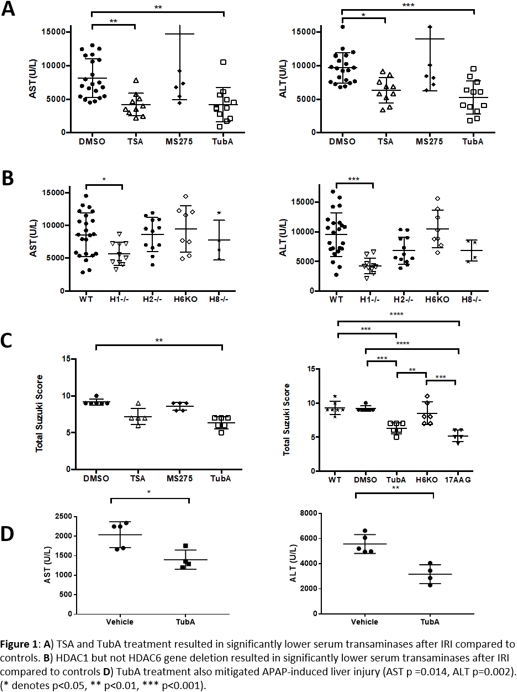Histone Deacetylase-6 Inhibition Mitigates Liver Ischemia-Reperfusion Injury and Acetaminophen Toxicity in Mice
1Surgery, University of Pennsylvania, Philadelphia, PA
2Surgery, Children's Hospital of Philadelphia, Philadelphia, PA
3Pathology and Laboratory Medicine, University of Pennsylvania, Philadelphia, PA
4Pathology and Laboratory Medicine, Children's Hospital of Philadelphia, Philadelphia, PA.
Meeting: 2018 American Transplant Congress
Abstract number: A83
Keywords: Graft survival, Ischemia, Liver transplantation
Session Information
Session Name: Poster Session A: Innate Immunity; Chemokines, Cytokines, Complement
Session Type: Poster Session
Date: Saturday, June 2, 2018
Session Time: 5:30pm-7:30pm
 Presentation Time: 5:30pm-7:30pm
Presentation Time: 5:30pm-7:30pm
Location: Hall 4EF
Introduction: Ischemia/reperfusion injury (IRI) leads to poor outcomes and early graft loss in liver transplantation. Understanding the mechanisms of liver IRI may aid in prevention and treatment. Histone deacetylases (HDACs) regulate diverse cellular processes; in the kidney, class I HDAC inhibition is protective of IRI. We sought to delineate the role of HDACs in liver IRI and in acetaminophen (APAP) induced liver injury.
Methods: Male wild type C57BL/6 mice(WT) were treated with pan-HDACi (TSA), class I HDACi (MS-275), HDAC6i (TubA), Hsp90i(17AAG), or control(DMSO) at 16 & 1h pre-IRI. Whole-body inducible knockout HDAC-1, -2, -6, and -8 and WT male mice were also assessed. Mice were subjected to 70% liver ischemia for 60min under temperature control. In the APAP experiments, WT mice were intraperitoneally given vehicle or TubA at 16h and just prior to a sublethal dose of APAP (500mg/kg). Histology, AST and ALT were assessed at 24h post injury.
Results: TSA and TubA treated mice developed significantly less liver injury after liver IRI than controls (Fig 1A). HDAC1 knockout, but not HDAC6 or 2, developed significantly less injury after IRI (Fig 1B). HDAC6 inhibition demonstrated decreased histologic injury (Figure 1C). TubA also mitigated APAP-induced injury (Fig 1D).
Conclusion: Pan-HDAC inhibition mitigates liver injury after IRI. Selective inhibition of HDAC1 via inducible gene deletion and pharmacologic inhibition of HDAC6 replicate this protection. These findings, distinct from the pattern in renal IRI, suggests tissue-specific roles for HDACs in IRI response. HDAC6 inhibition also mitigated APAP-induced liver injury, suggesting that the effects of TubA are not injury-type specific. Further experiments, including mechanistic studies, are required.
CITATION INFORMATION: Concors S., Murken D., Aufhauser D., Wang Z., Ge G., Bhatti T., Hancock W., Levine M. Histone Deacetylase-6 Inhibition Mitigates Liver Ischemia-Reperfusion Injury and Acetaminophen Toxicity in Mice Am J Transplant. 2017;17 (suppl 3).
To cite this abstract in AMA style:
Concors S, Murken D, Aufhauser D, Wang Z, Ge G, Bhatti T, Hancock W, Levine M. Histone Deacetylase-6 Inhibition Mitigates Liver Ischemia-Reperfusion Injury and Acetaminophen Toxicity in Mice [abstract]. https://atcmeetingabstracts.com/abstract/histone-deacetylase-6-inhibition-mitigates-liver-ischemia-reperfusion-injury-and-acetaminophen-toxicity-in-mice/. Accessed December 24, 2025.« Back to 2018 American Transplant Congress

